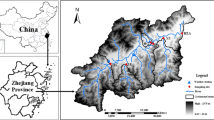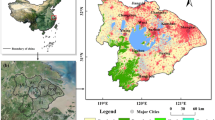Abstract
Legacy nitrogen (N) sources originating from anthropogenic N inputs (NANI) may be a major cause of increasing riverine N exports in many regions, despite a significant decline in NANI. However, little quantitative knowledge exists concerning the lag effect of NANI on riverine N export. As a result, the N leaching lag effect is not well represented in most current watershed models. This study developed a lagged variable model (LVM) to address temporally dynamic export of watershed NANI to rivers. Employing a Koyck transformation approach used in economic analyses, the LVM expresses the indefinite number of lag terms from previous years’ NANI with a lag term that incorporates the previous year’s riverine N flux, enabling us to inversely calibrate model parameters from measurable variables using Bayesian statistics. Applying the LVM to the upper Jiaojiang watershed in eastern China for 1980–2010 indicated that ~97 % of riverine export of annual NANI occurred in the current year and succeeding 10 years (~11 years lag time) and ~72 % of annual riverine N flux was derived from previous years’ NANI. Existing NANI over the 1993–2010 period would have required a 22 % reduction to attain the target TN level (1.0 mg N L−1), guiding watershed N source controls considering the lag effect. The LVM was developed with parsimony of model structure and parameters (only four parameters in this study); thus, it is easy to develop and apply in other watersheds. The LVM provides a simple and effective tool for quantifying the lag effect of anthropogenic N input on riverine export in support of efficient development and evaluation of watershed N control strategies.







Similar content being viewed by others
References
Bouraoui F, Grizzetti B (2014) Modelling mitigation options to reduce diffuse nitrogen water pollution from agriculture. Sci Total Environ 1267–1277:468–469
Chen DJ, Dahlgren RA, Shen YN, Lu J (2012) A Bayesian approach for calculating variable total maximum daily loads and uncertainty assessment. Sci Total Environ 430:59–67
Chen DJ, Huang H, Hu MP, Dahlgren RA (2014) Influence of lag effect, soil release, and climate change on watershed anthropogenic nitrogen inputs and riverine export dynamics. Environ Sci Technol 48:5683–5690
De Wit M, Meinardi C, Wendland F, Kunkel R (2003) Modelling water fluxes for the analysis of diffuse pollution at the river basin scale. Hydrol Process 14:1707–1723
Du XZ, Li XY, Zhang WS, Wang HL (2014) Variations in source apportionments of nutrient load among seasons and hydrological years in a semi-arid watershed: GWLF model results. Environ Sci Pollut Res 21:6506–6515
Dubrovsky NM, Hamilton PA (2010) The quality of our nation’s waters—nutrients in the nation's streams and groundwater: national findings and implications. US Geological Survey. Fact Sheet 2010–3078
Fang YT, Gundersen P, Mo JM, Zhu WX (2009) Nitrogen leaching in response to increased nitrogen inputs in subtropical monsoon forests in southern China. Forest Ecol Manag 257:332–342
Groffman PM, Law NL, Belt KT, Band LE, Fisher GT (2004) Nitrogen fluxes and retention in urban watershed ecosystems. Ecosystems 7:393–403
Hamilton SK (2012) Biogeochemical time lags may delay responses of streams to ecological restoration. Freshwater Biol 57:43–57
Han H, Allan JD, Scavie D (2009) Influence of climate and human activities on the relationship between watershed nitrogen input and river export. Environ Sci Technol 43:1916–1922
Han YG, Li XY, Nan Z (2011) Net anthropogenic nitrogen accumulation in the Beijing metropolitan region. Environ Sci Pollut Res 18:485–496
Han YG, Fan YT, Yang PL, Wang XX, Wang YJ, Tian JX, Xu L, Wang CZ (2014) Net anthropogenic nitrogen inputs (NANI) index application in Mainland China. Geoderma 213:87–94
Hong B, Swaney DP, Mörth C-M, Smedberg E, Hägg HE, Humborg C, Howarth RW, Bouraoui F (2012) Evaluating regional variation of net anthropogenic nitrogen and phosphorus inputs (NANI/NAPI), major drivers, nutrient retention pattern and management implications in the multinational areas of Baltic Sea basin. Ecol Modell 227:117–135
Howarth RW, Swaney DP, Boyer EW, Marino R, Jaworski N, Goodale C (2006) The influence of climate on average nitrogen export from large watersheds in the Northeastern United States. Biogeochemistry 79:163–186
Howarth RW, Swaney D, Billen G, Garnier J, Hong B, Humborg C, Johnes P, Mörth CM, Marino R (2012) Nitrogen fluxes from the landscape are controlled by net anthropogenic nitrogen inputs and by climate. Front Ecol Environ 10:37–43
Howden NJK, Burt TP, Worrall F, Whelan MJ (2011) Monitoring fluvial water chemistry for trend detection: hydrological variability masks trends in datasets covering fewer than 12 years. J Environ Monitor 13:514–521
Iqbal MZ (2002) Nitrate flux from aquifer storage in excess of baseflow contribution during a rain event. Water Res 36:788–792
Kopáček J, Hejzlar J, Posch M (2013) Factors controlling the export of nitrogen from agricultural land in a large central European catchment during 1900–2010. Environ Sci Technol 47:6400–6407
Li X, Wellen C, Liu G, Wang Y, Wang ZL (2014) Estimation of nutrient sources and transport using spatially referenced regressions on watershed attributes: a case study in Songhuajiang River Basin. China Environ Sci Pollut Res. doi:10.1007/s11356-014-3903-7
Lindsey BD, Phillips SW, Donnelly CA, Speiran GK, Plummer LN, Böhlke JK, Focazio MJ, Burton WC, Busenberg E (2003) Residence times and nitrate transport in ground water discharging to streams in the Chesapeake Bay Watershed. Water-Resources Investigations Report 03-4035. U.S. Geological Survey
McIsaac GF, David MB, Gertner GZ, Goolsby DA (2001) Eutrophication—nitrate flux in the Mississippi River. Nature 414:166–167
Meals DW, Dressing SA, Davenport TE (2010) Lag time in water quality response to best management practices: a review. J Environ Qual 39:85–96
Moriasi DN, Arnold JG, Van Liew MW, Bingner RL, Harmel RD, Veith TL (2007) Model evaluation guidelines for systematic quantification of accuracy in watershed simulations. Trans ASABE 50:885–900
Mulvaney RL, Khan SA, Hoeft RG, Brown HM (2001) A soil organic nitrogen fraction that reduces the need for nitrogen fertilization. Soil Sci Soc Am J 65:1164–1172
Phillips SW, Lindsey BD (2003) The influence of groundwater on nitrogen delivery to the Chesapeake Bay, Fact Sheet FS-091-03; U. S. Geological Survey: Denver, CO
Ravines RR, Schmidt AM, Migon HS (2006) Revisiting distributed lag models through a Bayesian perspective. Appl Stoch Models Bus Ind 22:193–210
Sanford WE, Pope JP (2013) Quantifying groundwater’s role in delaying improvements to Chesapeake Bay water quality. Environ Sci Technol 47:13330–13338
Sebilo M, Mayer B, Nicolardot B, Pinay G, Mariotti A (2013) Long-term fate of nitrate fertilizer in agricultural soils. Proc Natl Acad Sci U S A 110:18185–18189
Sharpley A, Jarvie HP, Buda A, May L, Spears B, Kleinman P (2013) Phosphorus legacy: overcoming the effects of past management practices to mitigate future water quality impairment. J Environ Qual 42:1308–1326
Shen J, Zhao Y (2010) Combined Bayesian statistics and load duration curve method for bacteria nonpoint source loading estimation. Water Res 44:77–84
Sheng WP, Yu GR, Fang HJ, Jiang CM, Yan JH, Zhou M (2014) Sinks for inorganic nitrogen deposition in forest ecosystems with low and high nitrogen deposition in China. PLoS ONE 9:e89322. doi:10.1371/journal.pone.0089322
Sobota DJ, Harrison JA, Dahlgren RA (2009) Influences of climate, hydrology, and land use on input and export of nitrogen in California watersheds. Biogeochemistry 94:43–62
Sun CC, Shen ZY, Liu RM, Xiong M, Ma FB, Zhang OY, Li YY, Chen L (2013) Historical trend of nitrogen and phosphorus loads from the upper Yangtze River basin and their responses to the three Gorges Dam. Environ Sci Pollut Res 20:8871–8880
Swaney DP, Hong B, Ti CP, Howarth RW, Humborg C (2012) Net anthropogenic nitrogen inputs to watersheds and riverine N export to coastal waters: a brief overview. Curr Opin Env Sust 4:203–211
Tesoriero AJ, Duff JH, Saad DA, Spahr NE, Wolock DM (2013) Vulnerability of streams to legacy nitrate sources. Environ Sci Technol 47:3623–3629
Ti CP, Yan XY (2013) Spatial and temporal variations of river nitrogen exports from major basins in China. Environ Sci Pollut Res 20:6509–6520
Van Breemen N, Boyer EW, Goodale CL, Jaworski NA, Paustian K, Seitzinger SP, Lajtha K, Mayer B, Van Dam D, Howarth RW (2002) Where did all the N go? fate of N inputs to large watersheds in the northeastern USA. Biogeochemistry 57(58):267–293
Worrall F, Burt TP, Howden NJK, Whelan MJ (2009) Fluvial flux of nitrogen from Great Britain 1974–2005 in the context of the terrestrial nitrogen budget of Great Britain. Global Biogeochem Cy 23:GB3017
Yan XY, Cai ZC, Yang R, Ti CP, Xia YQ, Li FY, Wang JQ, Ma AJ (2011) Nitrogen budget and riverine nitrogen output in a rice paddy dominated agricultural watershed in eastern China. Biogeochemistry 106:489–501
Acknowledgments
We thank the local government agencies for providing data critical for this investigation. This work was supported by the National Natural Science Foundation of China (41371010) and Zhejiang Provincial Natural Science Foundation of China (LY13D010002).
Author information
Authors and Affiliations
Corresponding author
Additional information
Responsible editor: Marcus Schulz
Randy A Dahlgren holds a Ph.D, University of California Davis.
Electronic supplementary material
Below is the link to the electronic supplementary material.
ESM 1
(DOC 1001 kb)
Rights and permissions
About this article
Cite this article
Chen, D., Guo, Y., Hu, M. et al. A lagged variable model for characterizing temporally dynamic export of legacy anthropogenic nitrogen from watersheds to rivers. Environ Sci Pollut Res 22, 11314–11326 (2015). https://doi.org/10.1007/s11356-015-4377-y
Received:
Accepted:
Published:
Issue Date:
DOI: https://doi.org/10.1007/s11356-015-4377-y




